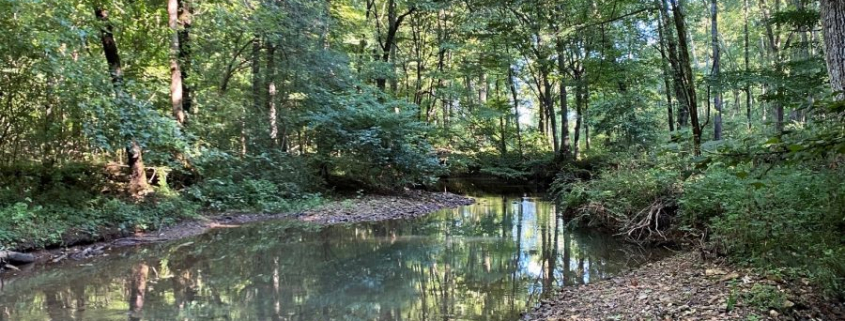Spiritual Wildness in an Urban Setting
August 12, 2022, I visited the 20-acre Indian Creek stream-side property owned and stewarded by Huntsville, Alabama’s Grace United Methodist Church, toured by my friend and Grace UMC parishioner Jim Chamberlain, a fellow Nature-enthusiast. It’s fitting that a church owns this sacred place, where I feel the nearness of a higher Power, immersed in a natural spiritual essence and filled with the hope of eternity. I’ve driven past the church dozens of times, paying no attention to it or the forest behind it. However, hidden in plain sight, the property serves as a reminder that Nature lies within easy reach to all of us, an island of urban wildness, rich with forest and edge plant and animal communities.
Streamside Forest
Indian Creek flows south from the property to first run along the Indian Creek Greenway at the Providence community, crosses Route 72, then parallels the Indian Creek Greenway. The Providence segment terminates just a few hundred feet below the church property. The stream had good summer flow, visually complementing the riparian forest lining it. At this point the church property reaches across the creek.
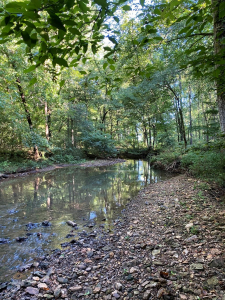
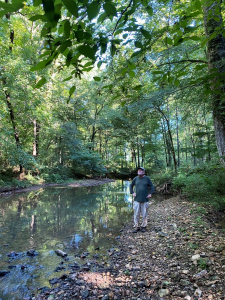
This rich bottomland supports a vibrant forest, including the largest tree we encountered, a 39-inch DBH (diameter breast height) southern red oak, wearing a tree moss skirt. The view left looks back into the stand toward the church, which sits safely well above the floodplain. The photo below right shows that the oak stands squarely in the flood zone, just fifty feet from the stream.
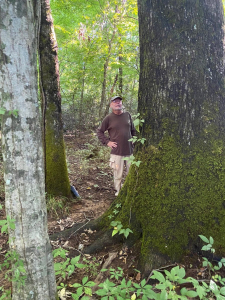
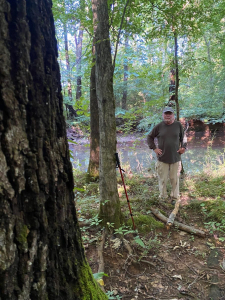
Jim captured this image of me with the oak. It’s not often that I have such an aura about me! Perhaps it is the spiritual essence of the place loaning its glow to an old forester.
The oak barely beat out the nearby yellow poplar, which we measured at 36-inches diameter breast height. Both trees stood greater than 100 feet, in their own way reaching heavenward, just as the parishioners do through their songs, prayers, and fellowship.
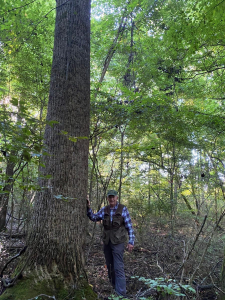
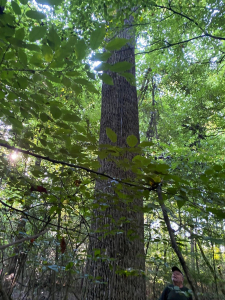
Here’s my 2:07 video centering on the poplar and giving you a taste of the riparian forest along Indian Creek:
https://www.youtube.com/watch?v=OM-EX7c0Ovc
I’ve spent many hours combing our north Alabama woods, yet here on the church forest I encountered my first-ever trifoliate orange (Citrus trifoliata), with its woody multiple thorns and, you guessed it, its leaves of three (i.e.trifoliate).
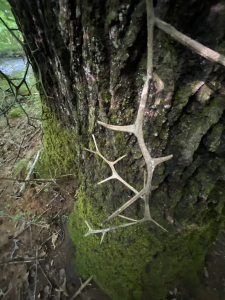
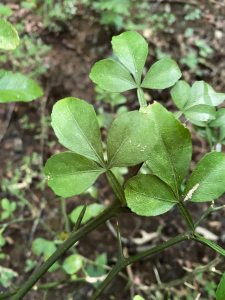
Because this is a strange new plant for me, I offer this description from a North Carolina Cooperative Extension reference:
Trifoliate Orange or Hardy Orange is a deciduous thorny shrub or small tree that grows up to nearly 20′ tall. This plant blooms in mid-spring and fruit ripens in early fall. Spines are sharp and numerous and are not for high traffic areas. This plant may be pruned into a thick, impenetrable hedge. This plant is an excellent winter character as specimen planting. This plant prefers well-drained, acid soil and full sun. It is intolerant of shady siting, is easily transplanted, and has no serious pest or disease problems.
The lemon-like fruit is exceedingly sour and full of seeds. If eaten in large quantities, the high acidity can cause severe stomach pain and nausea. Some people experience minor skin irritation with prolonged contact. While the peel and the pulp can be used to make marmalade, the fruit is often left on the tree to provide beauty well into winter.
Makes an excellent hedge, its thorns deterring entry. However, it can be somewhat invasive.
Admittedly, while happy to encounter this new (for me) species, the cited description does not engender warm feelings! The specimen I photographed is growing in full shade, thus explaining its less than robust condition. I suspect that it sprouted from seed washing downstream from a vibrant mother plant thriving in more favorable conditions. It was not lost on me that the woody thorns brought to mind a long-ago crown of thorns.
The orb weaver spider below at the top of its web is feverishly wrapping its dinner. Just as I glanced ahead, the hapless insect flew into the web. Within seconds the spider had immobilized and wrapped its future meal. Nature is harsh. It’s a spider-eats-insect world. So many people tend to think of Nature as an idyllic world characterized by peace and love…entirely cooperative and synergistic. I’ve heard idealists remark, “Why can’t we all get along…like in Nature?” Truth is, Nature is ruthlessly competitive. The food chain is fine, as long as you sit upon the apex. The spider loves the moth, freshly wrapped. A female praying mantis loves her mate — he tastes so good when she consumes him after coitus.
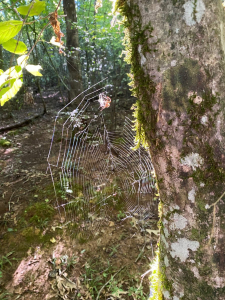
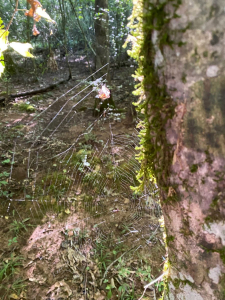
Here is Jim’s 11-second video of the spider in action, a sobering image and a stark reminder of Nature’s harshness:
https://photos.google.com/share/AF1QipPaQxoh5rn2EEsQTn5U3C7lvIrDIpo6sxiQxUaCaRZrFSog7sr87j0Yct8Jcy55uQ/photo/AF1QipNlStEd8bgzDwg2AQKacCzeVztTEmxmZmOTXukU?key=RENDMkdpZHFfMHdSdXlxMlZZaTNHLUxWUVlnZUJB
Here’s Jim’s still shot of yet another orb weaver web.
Nature is anything but the universally pleasant and peaceful place depicted in 1960s Disney movies.
I’ve read many recent much-ballyhooed pseudo-scientific tomes that address how caring trees in the forest are to one another. Instead, I see evidence in every stand that competition is brutal…to the victor go the spoils of space, moisture, and nutrients.
Upland Forest
Access to the upland forest is via the Grace Prayer Trail. Because we concentrated on the riparian forest, I failed to photo-cover the upland area. Perhaps on another visit we’ll spend more time in the mixed pine-hardwood forest.
Jim Chamberlain Photo
The Prayer Trail leads to a point for quiet reflection and prayer.
Jim Chamberlain Photo
Fairyland Portal
We entered the GUMC streamside forest through the adjacent riparian forest at Providence Elementary School, just downstream from the GUMC property. Students have created a fairyland for elves, gnomes, and other creatures of a fantasy world.
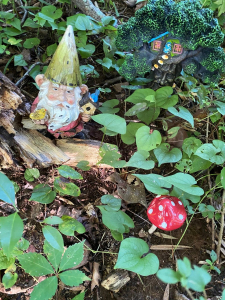
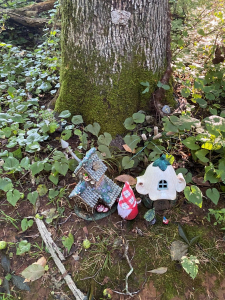
Even the trees have faces. I suppose it’s funny that the adjoining properties have different spiritual essences. The youth chose a more mirthful theme.
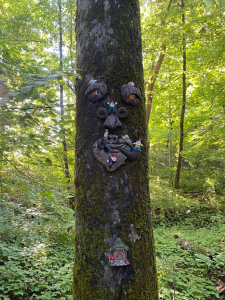
The Providence Greenway ends at the Elementary School property line.
Forest Edge
We walked along the church upland forest on the school driveway leading to its parking lot. The forest sits atop the rise north of the lot.
Jim Chamberlain Photos
We found several plants worthy of photographing within the edge along the property line. I am sure that most drivers thought little of the weeds along the lane as they prepared to drop off or pick up their kids. Instead, I saw the edge as botanically rich…a showy summer garden. Heart-leafed peppervine, a member of the grape family, grew into the trees. Although attractive, its fruit is inedible for humans.

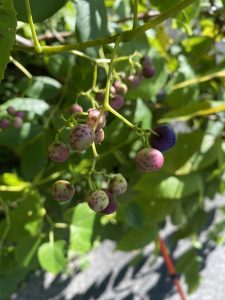
Common evening primrose did not seem to recognize that its name suggests an end of day flower period. The image at right with blurry flowers is intended to show its leaves.
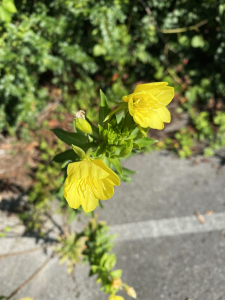
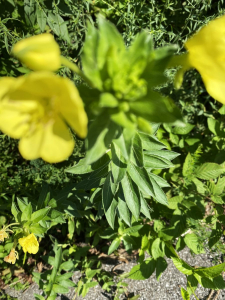
I really like the red morning glory’s diminutive orange-red flower (left) and its typical heart-shaped leaf (right). Unlike the evening primrose, the morning glory lived up to its moniker.
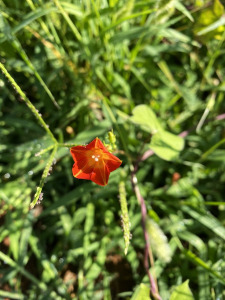
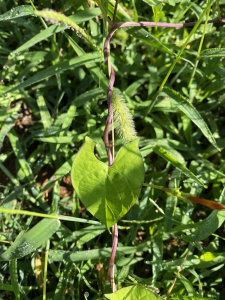
The common morning glory proudly displayed its iridescent blue petals and white center.

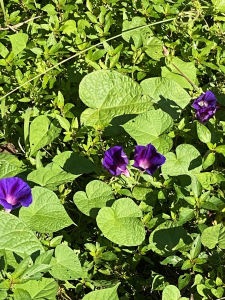
I am grateful for a chance to explore the riparian portion of a 20-acre parcel along Indian Creek. I know the creek from hiking and biking along both the Indian Creek Greenway. Because the watershed in dominated by urban and suburban communities, it flashes (floods) rapidly. The GUMC flood plain evidences frequent and significant flushes. In effect, the property represents an island of urban wildness, rich with forest and edge plant and animal communities. It serves as a reminder that Nature lies within easy reach to all of us.
Thoughts and Reflections
I offer these thoughts:
- Urban wildness lies within easy reach of nearly everyone who reads these words.
- Whether a church property or a public Park or Preserve, Nature’s Spirit is ever-present.
- Every tree, forest, and property has a story to tell!
Note: All blog post images created & photographed by Stephen B. Jones unless otherwise noted. Please circulate images with photo credit: “©2022 Steve Jones, Great Blue Heron LLC. All Rights Reserved.”
Another Note: If you came to this post via a Facebook posting or by an another route, please sign up now (no cost… no obligation) to receive my Blog Post email alerts: http://eepurl.com/cKLJdL
And a Third: I am available for Nature-Inspired Speaking, Writing, and Consulting — contact me at steve.jones.0524@gmail.com
Reminder of my Personal and Professional Purpose, Passion, and Cause
If only more of us viewed our precious environment through the filters I employ. If only my mission and vision could be multiplied untold orders of magnitude:
Mission: Employ writing and speaking to educate, inspire, and enable readers and listeners to understand, appreciate, and enjoy Nature… and accept and practice Earth Stewardship.
Vision:
- People of all ages will pay greater attention to and engage more regularly with Nature… and will accept and practice informed and responsible Earth Stewardship.
- They will see their relationship to our natural world with new eyes… and will understand more clearly their Earth home.
Tagline/Motto: Steve (Great Blue Heron) encourages and seeks a better tomorrow through Nature-Inspired Living!
Steve’s Three Books
I wrote my books Nature Based Leadership (2016), Nature-Inspired Learning and Leading (2017), and Weaned Seals and Snowy Summits: Stories of Passion for Place and Everyday Nature (2019; co-authored with Dr. Jennifer Wilhoit) to encourage all citizens to recognize and appreciate that every lesson for living, learning, serving, and leading is either written indelibly in or is powerfully inspired by Nature.
I began writing books and Posts for several reasons:
- I love hiking and exploring in Nature
- I see images I want to (and do) capture with my trusty iPhone camera
- I enjoy explaining those images — an educator at heart
- I don’t play golf!
- I actually do love writing — it’s the hobby I never needed when my career consumed me
- Judy suggested my writing is in large measure my legacy to our two kids, our five grand kids, and all the unborn generations beyond
- And finally, perhaps my books and Blogs could reach beyond family and touch a few other lives… sow some seeds for the future


All three of my books (Nature Based Leadership; Nature-Inspired Learning and Leading; Weaned Seals and Snowy Summits) present compilations of personal experiences expressing my (and co-author Dr. Wilhoit for Weaned Seals and Snowy Summits) deep passion for Nature. All three books offer observations and reflections on my relationship to the natural world… and the broader implications for society. Order any and all from your local indie bookstore, or find them on IndieBound or other online sources such as Amazon and LifeRich.

